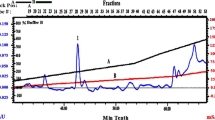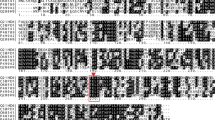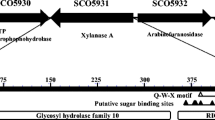Abstract
A gene encoding glycoside hydrolase family 11 xylanase (HoXyn11B) from Hypocrea orientalis EU7–22 was expressed in Pichia pastoris with a high activity (413 IU/ml). HoXyn11B was partly N-glycosylated and appeared two protein bands (19–29 kDa) on SDS-PAGE. The recombinant enzyme exhibited optimal activity at pH 4.5 and 55 °C, and retained more than 90% of the original activity after incubation at 50 °C for 60 min. The determined apparent K m and V max values using beechwood xylan were 10.43 mg/ml and 3246.75 IU/mg, respectively. The modes of action of recombinant HoXyn11B on xylo-oligosaccharides (XOSs) and beechwood xylan were investigated by thin-layer chromatography (TLC), high-performance liquid chromatography (HPLC), and matrix-assisted laser desorption/ionization time-of-flight mass spectrometry (MALDI-TOF-MS), which indicated that the modes of action of HoXyn11B are different from HoXyn11A since it is able to release a significant amount of xylose from various substrates. This study provides an opportunity to better understand the hydrolysis mechanisms of xylan by xylanases from Trichoderma.





Similar content being viewed by others
References
Xue, S., Uppugundla, N., Bowman, M. J., Cavalier, D., Da Costa Sousa, L., E Dale, B., & Balan, V. (2015). Sugar loss and enzyme inhibition due to oligosaccharide accumulation during high solids-loading enzymatic hydrolysis. Biotechnology for Biofuels, 8, 195.
Buruiana, C.-T., Gómez, B., Vizireanu, C., & Garrote, G. (2017). Manufacture and evaluation of xylooligosaccharides from corn stover as emerging prebiotic candidates for human health. LWT - Food Science and Technology, 77, 449–459.
Peng, F., Peng, P., Xu, F., & Sun, R. C. (2012). Fractional purification and bioconversion of hemicelluloses. Biotechnology Advances, 30, 879–903.
Paës, G., Berrin, J.-G., & Beaugrand, J. (2012). GH11 xylanases: structure/function/properties relationships and applications. Biotechnology Advances, 30, 564–592.
Uday, U. S. P., Choudhury, P., Bandyopadhyay, T. K., & Bhunia, B. (2016). Classification, mode of action and production strategy of xylanase and its application for biofuel production from water hyacinth. International Journal of Biological Macromolecules, 82, 1041–1054.
Li, H., Wu, J., Jiang, F., Xue, Y., Liu, J., Gan, L., Ali, N., & Long, M. (2015). Functional expression and synergistic cooperation of xylan-degrading enzymes from Hypocrea orientalis and Aspergillus niger. Journal of Chemical Technology & Biotechnology, 90, 2083–2091.
Pollet, A., Delcour, J. A., & Courtin, C. M. (2010). Structural determinants of the substrate specificities of xylanases from different glycoside hydrolase families. Critical Reviews in Biotechnology, 30, 176–191.
Pollet, A., Schoepe, J., Dornez, E., Strelkov, S. V., Delcour, J. A., & Courtin, C. M. (2010). Functional analysis of glycoside hydrolase family 8 xylanases shows narrow but distinct substrate specificities and biotechnological potential. Applied Microbiology and Biotechnology, 87, 2125–2135.
van Gool, M. P., van Muiswinkel, G. C., Hinz, S. W., Schols, H. A., Sinitsyn, A. P., & Gruppen, H. (2012). Two GH10 endo-xylanases from Myceliophthora thermophila C1 with and without cellulose binding module act differently towards soluble and insoluble xylans. Bioresource Technology, 119, 123–132.
Xu, X.-Q., Wu, X.-B., Cui, Y., Cai, Y.-X., Liu, R.-W., Long, M.-N., & Chen, Q.-X. (2014). Enzymatic saccharification of cassava residues and glucose inhibitory kinetics on β-glucosidase from Hypocrea orientalis. Journal of Agricultural and Food Chemistry, 62, 11512–11518.
Li, H., Liu, J., Wu, J., Xue, Y., Gan, L., & Long, M. (2014). Comparative analysis of enzymatic hydrolysis of Miscanthus xylan using Aspergillus niger, Hypocrea orientalis, and Trichoderma reesei xylan-degrading enzymes. Bioresources, 9.
Prasad Uday, U. S., Bandyopadhyay, T. K., Goswami, S. and Bhunia, B. (2016) Optimization of physical and morphological regime for improved cellulase free xylanase production by fed batch fermentation using Aspergillus niger (KP874102.1) and its application in bio-bleaching. Bioengineered, 1–10.
Reddy, S. S., & Krishnan, C. (2016). Production of high-pure xylooligosaccharides from sugarcane bagasse using crude β-xylosidase-free xylanase of Bacillus subtilis KCX006 and their bifidogenic function. LWT - Food Science and Technology, 65, 237–245.
He, J., Yu, B., Zhang, K., Ding, X., & Chen, D. (2009). Expression of endo-1, 4-beta-xylanase from Trichoderma reesei in Pichia pastoris and functional characterization of the produced enzyme. BMC Biotechnology, 9, 56.
Daly, R., & Hearn, M. T. (2005). Expression of heterologous proteins in Pichia pastoris: a useful experimental tool in protein engineering and production. Journal of Molecular Recognition, 18, 119–138.
Bailey, M. J., Biely, P., & Poutanen, K. (1992). Interlaboratory testing of methods for assay of xylanase activity. Journal of Biotechnology, 23, 257–270.
Laemmli, U. K. (1970). Cleavage of structural proteins during the assembly of the head of bacteriophage T4. Nature, 227, 680–685.
Bradford, M. M. (1976). A rapid and sensitive method for the quantitation of microgram quantities of protein utilizing the principle of protein-dye binding. Analytical Biochemistry, 72, 248–254.
Li, H., Long, C., Zhou, J., Liu, J., Wu, X., & Long, M. (2013). Rapid analysis of mono-saccharides and oligo-saccharides in hydrolysates of lignocellulosic biomass by HPLC. Biotechnology Letters, 35, 1405–1409.
Li, H., Xue, Y., Wu, J., Wu, H., Qin, G., Li, C., Ding, J., Liu, J., Gan, L., & Long, M. (2016). Enzymatic hydrolysis of hemicelluloses from Miscanthus to monosaccharides or xylo-oligosaccharides by recombinant hemicellulases. Industrial Crops and Products, 79, 170–179.
Wu, H., Li, H., Xue, Y., Luo, G., Gan, L., Liu, J., Mao, L., & Long, M. (2017). High efficiency co-production of ferulic acid and xylooligosaccharides from wheat bran by recombinant xylanase and feruloyl esterase. Biochemical Engineering Journal, 120, 41–48.
Cayetano-Cruz, M., Pérez de los Santos, A. I., García-Huante, Y., Santiago-Hernández, A., Pavón-Orozco, P., López y López, V. E., & Hidalgo-Lara, M. E. (2016). High level expression of a recombinant xylanase by Pichia pastoris cultured in a bioreactor with methanol as the sole carbon source: Purification and biochemical characterization of the enzyme. Biochemical Engineering Journal, 112, 161–169.
Acknowledgements
This work was supported by the Natural Science Foundation of Guangdong Province, China (2016A030310124); the National Natural Science Foundation of China (Grant No. 31600475); the project of Guangzhou Science and Technology (201707010241); the research fund from the Xiamen Southern Oceanographic Center (No. 14GZP59HJ29); Fujian Provincial Department of Ocean and Fisheries (No. 2015-27); and President Fund of Xiamen University (20720150090).
Author information
Authors and Affiliations
Corresponding authors
Rights and permissions
About this article
Cite this article
Li, H., Wu, H., Jiang, F. et al. Heterologous Expression and Characterization of an Acidic GH11 Family Xylanase from Hypocrea orientalis . Appl Biochem Biotechnol 184, 228–238 (2018). https://doi.org/10.1007/s12010-017-2532-2
Received:
Accepted:
Published:
Issue Date:
DOI: https://doi.org/10.1007/s12010-017-2532-2




